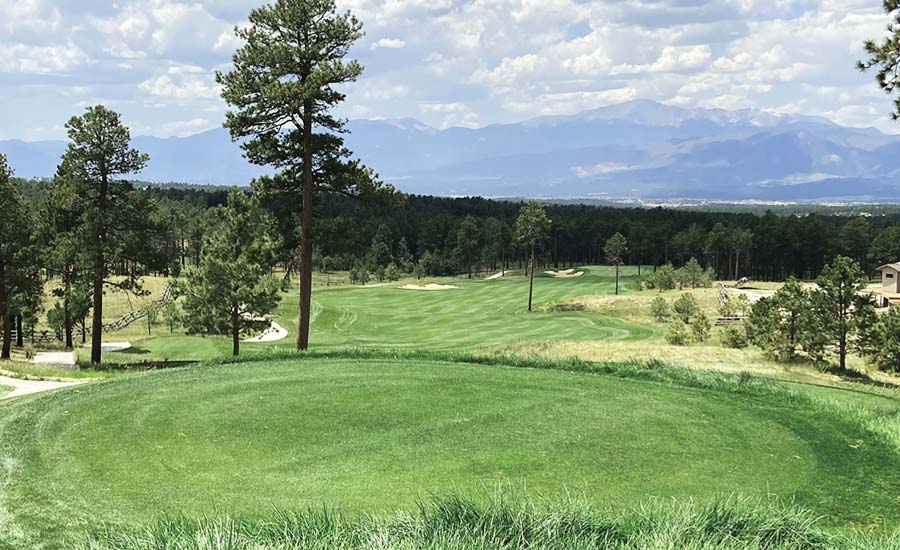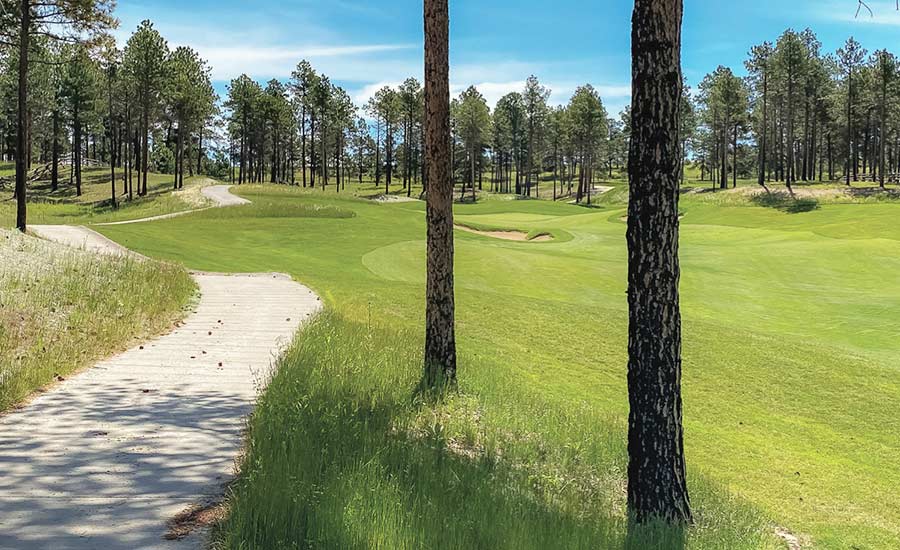Drive Away Hunger Golf Classic 2025
Join Community Table on August 25 at Fossil Trace Golf Club

By Jon Rizzi
AT THE DAWN of the millennium, Classic Homes founder and owner Jeff Smith followed his true north to northern Colorado Springs, creating the luxury Flying Horse development on 1,600 acres 10 miles east of the U.S. Air Force Academy. Today, more than 1,400 homes comprise the thriving community anchored by The Club at Flying Horse and its breathtaking Tuscan-style clubhouse, first-rate steakhouse, sprawling athletic facility and spa, vast outdoor pool complex and a 15-year-old Tom Weiskopf Signature golf course.
Members delight in those amenities, as do guests of the 48-room Lodge at Flying Horse, the property’s boutique hotel, which opened in 2015 and next year will double in size—just like what recently happened to the number of Flying Horse golf courses.
This September, Flying Horse debuted its second 18-hole layout five miles from the original one. And once again, Smith pointed his compass north—this time towards 1,400 acres atop the Palmer Divide in the Black Forest.
For an architect, he engaged Phil Smith (no relation), who as Weiskopf’s exclusive course designer for 14 years played a pivotal role in designing the original Flying Horse course and had since hung out his own shingle.
“When I first walked the site in 2012, I told Jeff and (General Manager) Fredo (Killing), ‘I’ve looked at 100 sites in my career, and this is in the top five…top three…maybe the best,’” he says, citing the combination of ponderosa pine forest, rolling ranchland, dramatic elevation changes, sand-based soil and views of Pikes Peak. “My job was not to screw it up.”

He didn’t. Given free rein to lay out the course before any of the property’s 283 homes— all of which will occupy 2.5-to 5.2-acre lots— were sited, Smith sculpted 7,166 yards of memorable golf that flow seamlessly with the land. “We didn’t have to shoehorn in any holes,” he says, “and none of them distract from the surrounding views.”
When asked which of those holes is his favorite, he avoids the cliché of likening it to naming a preferred offspring. “If I asked 18 of you that question after a round, I’d want to hear 18 different answers,” he explains to a group of members during a late-August preview tour of the course. “Otherwise, I haven’t done my job.” Facing Pikes Peak as you tee off to a rippling fairway 100 feet below, you’d be hard-pressed not to vote for the 431-yard par-4 opener, a dog-leg-right statement-maker with a lone ponderosa
pine at the elbow serving as the aiming point. Then again, there’s a lot to love about the second and the fourth, which clock in at identical yardages as the opener, but differ completely, with the left-dogleg second playing 35 feet uphill to a catcher’s mitt-style green and the straight on fourth featuring a narrow, bunkerless fairway and a huge, cross-bunkered green complex with plenty of movement.
A trip out of the pines and past the four-level, 16-acre practice range leads to the prairie side of Palmer Divide—six grassland holes on which the only trees are logs forming the crossbuck fencing that lattices the native areas.
“The trick was to make sure holes 5-10 stood up to the ones in the forest,” states Smith, a Hutchinson, Kan. native who was more than equal to the task, having worked at the fabled Prairie Dunes Golf Club. During the grow-in, Smith notes, the exposed holes also had to stand up to the soil-eroding rains and desiccating winds more than the ones shielded by the conifers did—a challenge ably met by Agronomy and Facility Operations Director Dan Hawkins.
Scoring chances await on the prairie, as three of the course’s four par 5s—including the No. 1 handicap eighth—appear here. So do wider fairways and larger bunkers to lend perspective and accommodate the elements and grander scale of the surroundings, which include a sizable retention pond fronting the into-the-wind, all-carry 190-yard par-3 sixth.

A shorter par 3 marks your return to the Black Forest on hole 11, followed by the brawny downhill 12th. With views of Pulpit Rock in the distance, this serene 480-yarder is the longest par 4 on the course, but it’s not the hardest. That comes next, on the gorgeous 430-yard right-dog-leg 13th, which demands avoiding the left fairway bunker as you position your tee shot away from the pines on the right, leaving a long iron into a very shallow, testy green.
As with the front nine, consecutive holes of the same length don’t look or play the same way. The 427-yard 14th doglegs in the opposite direction as the 13th, around wetlands formed by the drainage from Palmer Divide, while a lone tree blocks the left approach to the green.

North’s last four holes all force decisions off the tee, beginning with the visually deceptive downhill par-3 15th. Do you avoid the bunker snuggling up to the front of the green—or check the yardage book to learn that sandy expanse actually lies 30 yards short of the putting surface? On the 410-yard 16th, do you take the safe route left of the center-fairway bunker and risk the greenside bunkers on your approach, or do you sneak it through the tree-pinched right-hand side for a better look?
The only “reachable” par 4—and the only one measuring less than 400 yards—comes at the 348-yard 17th. Driving the elevated green or having the best angle into it demands clearing an escarpment jutting into the upper, left side of the fairway. The apparent “safe” route to the right hazards an approach from behind the trees.
Flying Horse North finishes as strongly as it starts: a gorgeous, risk-reward right-dogleg hole that’s the shortest par 5 on the course. With the green visible from the tee 518 yards away, and plenty of bunkers in between, matches can close with anything from eagle to an eight. And should there be a bet to be settled, a sweet 100-yard 19th hole waits on the ridge near the yet-to-be-constructed clubhouse.
“Nobody should play this hole sober,” Smith jokes to his gallery.
By all accounts, the avuncular Smith did his job without ego, working collaboratively with Killing, Hawkins, Assistant GM Glenn Wallace, PGA Professional Jake O’Dell and Frontier Golf VP Jason Nau—“the best in the business,” according to Smith—whose team built and shaped the course.
Given the completely different terrains, the architect made sure that any similarities between the original Flying Horse course and North confined themselves to the logo, turf types (T1 bent on the greens and fast-germinating ryegrass in the fairways, tees and rough) and the use of quick-draining Capillary concrete bunker liners.
Unlike the main course, North abounds in trees. The native areas are less penal, the teeing areas and bunkers more free-form. Homes tuck into the woods and there are no blind shots.
Averaging 6,500 square feet, the putting surfaces are extremely receptive for a new course, thanks to a decision to build and grass them before the tees and fairways. Their wavy contours suggest large potato chips, with an occasional ridge, false front or meandering swale, but never sloping more than 2.5 percent in the pinnable areas.
“North’s greens are completely different than the ones on the main course,” shares Flying Horse’s six-time stroke-play champion Russ Ford, who took three days off work to play North when it opened. “On the main course, if you get it on the correct tier, it’s pretty flat by the hole, whereas on the new course, you have to learn to play the breaks.”
As of August 31, Ford was among the 144 of Flying Horse’s 343 Full Golf members who’d upgraded to a Signature Golf membership, which includes access to both courses. A Flying Horse North-only membership does not currently exist, and members who haven’t upgraded to Signature status can play North six times a year for $119 per round. New Signature Golf members pay a nonrefundable $35,000 (or a partially refundable $50,000) initiation with $732 in monthly dues, while those amounts for new Full Golf members are $25,000 (or $39,000) and $610.
You don’t have to join to play, however. Guests at the soon-to-be expanded 4-Star Lodge at Flying Horse can get tee times at either course for $189. And if you’re interested in building your mountain manse at Flying Horse North, know that the 82-home first phase released by Classic Homes recently sold out in 30 days, and original lot prices of $150,000 to $500,000 are, predictably, heading north.
Jon Rizzi is Colorado AvidGolfer’s founding editor. For more information: flyinghorseclub.com; 719-494-1222.
This article was also featured in the Fall issue of Colorado AvidGolfer.
Colorado AvidGolfer is the state’s leading resource for golf and the lifestyle that surrounds it, publishing eight issues annually and proudly delivering daily content via coloradoavidgolfer.com.
Join Community Table on August 25 at Fossil Trace Golf Club
Steamboat Springs is like a secret only you and your friends know
Vail Valley is home to an endless array of summer outdoor pursuits